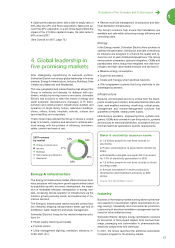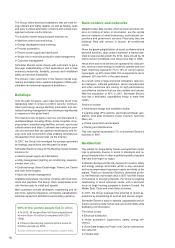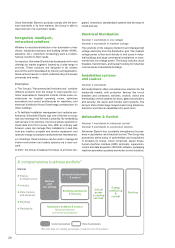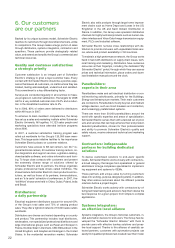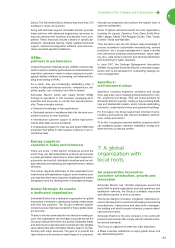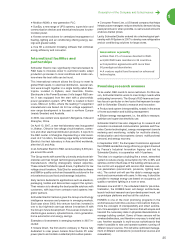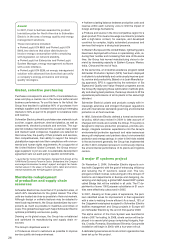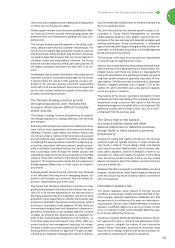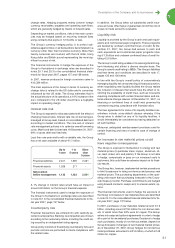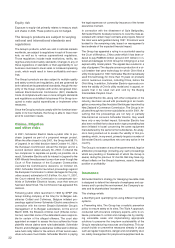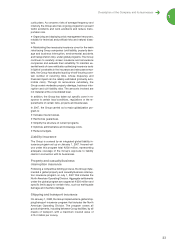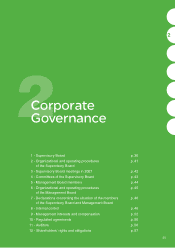APC 2007 Annual Report Download - page 28
Download and view the complete annual report
Please find page 28 of the 2007 APC annual report below. You can navigate through the pages in the report by either clicking on the pages listed below, or by using the keyword search tool below to find specific information within the annual report.
26
Global, selective purchasing
Purchases correspond to around 50% of consolidated rev-
enue and play a crucial role in the Group’s technical and
business performance. To use this lever to the fullest, the
Group has decided to globalize 80% of purchases from
strategic suppliers and increase local sourcing in emerging
markets to 50% as part of its program to re-balance costs
and revenue.
Schneider Electric primarily purchases raw materials such
as silver, copper, aluminum, steel and plastics, as well as
components, electronic products and services. The sup-
plier list includes international firms, as well as many small
and medium sized companies. Suppliers are selected for
their know-how, the quality of their products and services,
their competitiveness, their ability to support the Group’s
globalization approach and their compliance with environ-
mental and human rights requirements. As a supporter of
the United Nations’ Global Compact, the Group encour-
ages suppliers to join as well. A sustainable development
agreement sets out each party’s specific commitments.
* Launched by former UN Secretary General Kofi Annan at the
1999 World Economic Forum in Davos, Switzerland, the Compact
encourages businesses to adopt, support and apply ten funda-
mental values in the areas of human rights, labor and environ-
mental standards and the fight against corruption.
Worldwide redeployment
of production and supply chain
resources
Schneider Electric has more than 211 production sites, of
which 45% manufacture for the global market. The other
units are located as close as possible to their end markets.
Although design or esthetic features may be adapted to
meet local requirements, the Group standardizes key com-
ponents as much as possible to maximize economies of
scale. This global/local approach helps Schneider Electric
optimize profitability and service quality.
Drawing on its global scope, the Group has re-balanced
and optimized its manufacturing and supply chain re-
sources.
The Group’s objectives were to:
Produce as close to customers as possible to improve
service quality and responsiveness.
Award
In 2007, Frost & Sullivan awarded its product
innovation prize for North America to Schneider
Electric in the area of energy quality and energy
management solutions.
These innovations included:
PowerLogic ION 8800 and PowerLogic ION
8600, two devices that allow distributors to
invoice energy consumption while complying
with legislation on network stability.
PowerLogic Ion Enterprise and PowerLogic
System Manager, energy management software
with a web interface.
PowerLogic ION EEM, an energy management
solution with advanced functions that can unify
a company’s energy, emissions and energy
quality strategies.
Achieve a lasting balance between production costs and
revenue within each currency zone to limit the impact of
foreign exchange fluctuations.
Produce and source in the most competitive region for a
given product. This means low-wage countries for products
with a high labor content, for example, and developed
countries for complex, highly automated processes and
services that require a strong local presence.
In Western Europe and the United States, rightsizing plans
have been deployed with a focus on specializing units, re-
ducing their number and increasing their size. At the same
time, the Group has moved manufacturing closer to de-
mand by increasing capacity in Eastern Europe, Mexico,
India, China and the rest of Asia.
At the same time, an industrial excellence program called
Schneider Production System (SPS) has been deployed
in all plants to substantially and continuously improve qual-
ity, service and productivity. Based on a Lean Manufactur-
ing approach, SPS is supported by the extension of Six
Sigma and Quality and Value Analysis programs across
the Group. By deploying these optimization methods glob-
ally and sharing best practices, the Group intends to lift the
operational performance of all its plants to the same high
standard.
Schneider Electric’s plants and products comply with in-
creasingly extensive and stringent European regulations
and with international standards governing environmental
protection in all host countries.
In 1992, Schneider Electric defined a formal environmen-
tal policy, which was revised in 2004 to take account of
changes both inside and outside the Group. This policy is
designed to improve production processes, promote eco-
design, integrate customer expectations into the Group’s
environmental protection approach and raise awareness
among all employees and partners about environmental
protection and energy savings. In order to limit risks related
to the environment generally, the Group has implemented
an ISO 14001-compliant process to continuously improve
the environmental performance of its plants and logistics
centers.
A major IT systems project
On November 2, 2004, Schneider Electric signed a con-
tract with Capgemini with the goal of enhancing efficiency
and reducing the IT function’s overall cost. The two-
pronged contract involves outsourcing all of the Group’s IT
functions and departments in Europe and designing, de-
veloping and deploying a global SAP-based ERP system
called Bridge that will be installed in all units. The IT de-
partments of some 100 European subsidiaries in 31 coun-
tries were effectively outsourced in 2005.
In 2007, drawing on three years of experience, the part-
ners identified areas for improvement in their agreement
with a view to making it more efficient. As a result, 13% of
the Capgemini employees assigned to Schneider Electric
facilities management and Group projects in Europe will
join Schneider Electric by the end of first-quarter 2008.
The alpha version of the Core System was launched in
India in 2007 for testing. In 2008, a beta version will be de-
ployed in a second pilot group comprising Hungary, Aus-
tria, Croatia, Romania, Slovakia and Slovenia. Group-wide
installation will begin in 2009, with a four-year roll-out.
A dedicated governance and cost-control organization has
been set up for this project.



